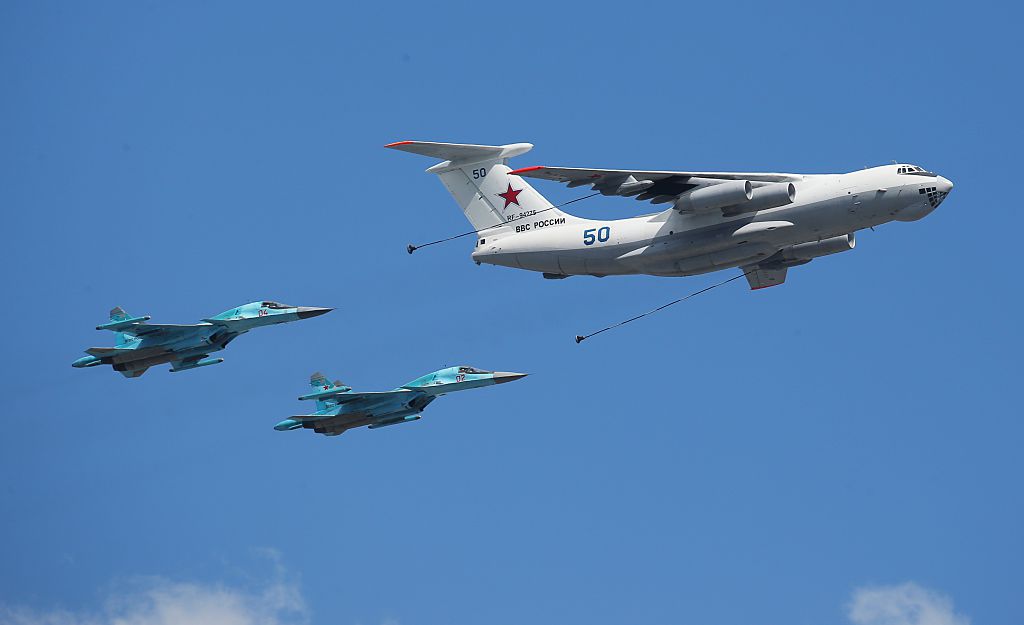High Above the Trenches, Ukraine Gaining Ground, So To Speak, With Victories in the Skies
A ban by Russia on export of gasoline signals a broad attack by drones on energy infrastructure is making its mark in the war.

On the ground, Ukrainian soldiers are on the defensive, outgunned and outmanned by Russia. In the air, it’s a different story. Over the last two weeks, Ukrainian gunners have shot down almost $1 billion worth of Russian war jets. Last Saturday, on the war’s second year anniversary, Ukrainian kamikaze drones penetrated 300 miles into Russia and caused a big fire at Russia’s largest steelworks.
Yesterday, Russia’s deputy prime minister, Alexander Novak, ordered a six-month ban on exports of gasoline. Behind the freeze was a Ukrainian drone campaign that hit ten oil refineries and tank farms last month, causing major fires at sites along a 1,000-mile stretch of European Russia. The world’s third-largest oil producer, Russia accounts for 12 percent of global production,
With yesterday’s downing of two Su-34 attack bombers — NATO reporting name ‘Fullback’ — Ukraine has downed the $36 million supersonic jets at the rate of one a day. Since February 17, Ukraine has downed nine Su-34s and two Su-35s. The latter are $60 million fighter jets with the NATO reporting name “Flanker.”
“Wow! One more Sukhoi-34 down today. Two all together so far,” a Ukrainian ambassador-at-large, Olexander Scherba, posted Tuesday on X. “The hunting season in full swing.” Bringing the war home to Russia’s capital, a fire last Saturday damaged a Sukhoi parts warehouse near the company headquarters, at central Moscow’s Begevoy district.

This helps Ukrainian soldiers on the ground. A Ukrainian Air Force spokesman, Yurii Ihnat, said on television last week: “The closer [Russian] aircraft armed with guided bombs approach, the deeper those bombs can reach into our defenses.”
Equally damaging to Russia’s air war, Ukrainian rockets, probably S-200 surface to air missiles, shot down last Friday a rare and costly Beriev A-50 AWACS, or Airborne Warning and Control System, plane. Crucial for coordinating air traffic and providing ground radar, a Beriev is packed with digital upgrades, raising its price tag to $500 million. Last month, the Ukrainians shot down another Beriev, leaving Russia with only six.
“There are still six planes left,” Ukraine’s military intelligence chief Kyrylo Budanov told the “Ukraine 2024” forum in Kyiv Sunday. “That’s two full shifts. If another A-50 goes down, round-the-clock coverage will have to be stopped.”
Britain’s Defense Ministry posted Tuesday on X of the AWACS shootdown: “This latest Ukrainian success has demonstrated a continued Russian inability to protect high value air assets. It brings into question the efficacy of Russian air planners.” According to Ukraine’s Defense Ministry, Russia has lost 342 jet warplanes in the two-year conflict. This is nearly three times the 118 fighter bombers that the Soviet Union lost during its decade-long intervention in Afghanistan.
Ukraine is expected to further regain control of its airspace this summer when Ukraine’s first F-16s are to take to the air. This year, Belgium, Denmark, Norway, and the Netherlands are giving Ukraine almost all their F-16 fighter jets, about 100 aircraft in total. The NATO countries are buying the more modern F-35s.
For an air war of a different sort, Ukraine plans to produce this year “thousands” of long range drones with the capacities to hit Moscow and Saint Petersburg, Ukraine’s digital minister, Mykhailo Fedorov, told Reuters two weeks ago. Carrying explosives up to 600 miles, these kamikaze drones will put in danger a swath of Russia twice the size of California, calculates Verstka, an independent Russian investigative news outlet.
On the war anniversary Saturday, long range drones hit the Novolipetsk Steel plant, responsible for 18 percent of Russia’s steel output. While plant managers publicly minimized the damage, video posted on social media in Lipetsk showed a big explosion, with orange flames lighting up the night. Although company officials say their rolled steel only goes for civilian uses, Ukrainian officials say it also goes for artillery shells, missiles and drones.
Attacking Russia’s energy infrastructure, the nation’s economic lifeblood, Ukrainian drones are hitting Russian oil refineries, storage tanks, and export terminals. Refinery output dipped in January, contributing to the government’s decision to freeze gasoline exports starting March 1.
“The Ukrainian air strike campaign targeting high-value energy assets inside Russia is likely to expand in the coming months,” predict two analysts for the Kyiv-based Center for Defense Strategies, Victoria Vdovychenko and Alexander Khara. In an Atlantic Council essay titled “Ukrainian long-range drones target Putin’s war machine inside Russia,” they write: “If drone attacks succeed in causing significant disruption to Russia’s economically vital energy sector, this could negatively impact military operations in Ukraine and domestic stability in Russia.”
Faced with trying to protect military industrial sites in the world’s largest country, Russian defense officials also may have to look beyond the 600-mile range from Ukraine. On February 15, a major explosion shook a high security military manufacturing plant in Biysk, a Siberian city 2,500 miles east of Ukraine.
Owned by Russian space agency Roscosmos, the plant “produces…ammunition, solid propellant charges for rocket engines and explosives for industrial purposes,” reports Meduza, an independent Russian news site based in Latvia. The facility has been sanctioned by Ukraine, the United States, and the European Union.
Explanations vary for the daytime explosion, which sent up a huge white cloud widely visible across the city of 180,000. It could have been the result of an accident or sabotage. Or it could have been caused by a kamikaze drone secretly launched by Ukrainian agents in Kazakhstan or Mongolia, two countries with borders only 200 miles south of Biysk.

